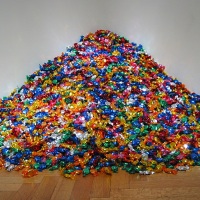In his new book, “Library of Dust”, photographer David Maisel documents one of the most other-wordly, enigmatic, and heartbreaking photo projects I’ve ever seen. I simply can’t stop thinking about it, and when I try the thoughts of it just burst out into whatever I happen to be doing.
To me, it’s an achingly beautiful scientific truth that energy cannot be destroyed. The amount of it in the universe is finite, but it can be shifted and morphed into other forms. Everything is made of something else. When something dies it never really disappears; it’s taken by everything around it and fashioned into something brand new. No matter what purpose or import we think we may hold in our current state, inevitably, immutably, our destinations are all the same: in the end, we all become something else.
The Oregon State Insane Asylum, as it was first named, opened in 1883. While it operated until the early 1970s, some of the patients who died within its walls, unclaimed by their families, were cremated and their remains were sealed inside copper canisters.
With nobody coming to collect them, the canisters were placed in a room on long pine shelves. That’s where they’ve sat, some for more than a century…in limbo. Always waiting. When Maisel was first allowed entry he found that the canisters, neatly numbered on top from 01 to 5118, had exploded with patterns. Leeched and corroded and etched minerals traced their way across them, each pattern completely unique. 5118 human souls refracting themselves, through metal, into colour. On his first visit, inmates from a local prison were brought in to clean the hallways and other areas surrounding the usually-locked room of canisters. One of the men looked in and whispered “the library of dust.” And so Maisel had the title for his project.
Stored away for lack of alternative, not enshrined and cherished like so many others whose physical remnants are stored or celebrated, these humans’ bodies are after-thoughts. Whispers in a jar. Even though their lives and purpose might have been shuffled away – their difficult minds condemned for the sake of our convenience – the persistence of their dust is an ultimate inconvenience; try as you might to will and wish them aside they are all still here. In rows and stacks. And they want to be heard.
I don’t pretend to know what happens to people when they die, but I do know that everyone, everywhere, yearns to be acknowledged. Recognized and noted. Stars shine to be seen, waves crash to be heard, and even in death, or perhaps because of death, the matter we’ve left behind cries out as the energy that inhabited it ebbs out and finds its new purpose. Our bodies need to know that their sudden absence of spirit has been recorded. So that they can let go and their energy can move on.
This yearning cannot be stopped or impeded. The transference of spirit is a declaration of desire, of molecules and atoms and particles searching for newness once their home suddenly turns into a shell. It’s an eternal, unbroken cycle. Since The Big Bang everything has been connecting, living, dying, then connecting again… and so it goes. Denied their next connection, cycles slowed, these canisters find their way and reach out to us. Just like flower petals they open to attract attention, somehow wise enough to know that if routine or ceremony or just plain old decency isn’t enough to be remembered then they can always appeal to our vanity. So they’ve made themselves beautiful. They’ve willed themselves to crystalize, galvanize through their man-made metal casing, and catalyze outwards. Like a hand reaching forward, palm up. Silently, they ask for their rightful turn.
The organic, elemental shapes they’ve taken are no coincidence. Denied their transference, they manifest outwards as visual embodiments of what they might have become: a river’s edge, a leaf curl, a glacier, the azure of sky, the stratus of a cloud, or the pure, stark light of an aurora borealis. Aquatic and terrestrial and celestial, they mimic all the things that have been held from them.
David Maisel has taken photographs that give them rest. That complete the circuit of hope, to despondency, to resolve, to quiet triumph that they’ve traveled. These 5000 forgotten ones call out to us and say “Look. I was here once.” And when we consider these pictures we can absolve them by taking a moment, with grace, to look back and say “I see you. I know.”
















At first sounds sad but look like beautiful works of art.
thanks for this photo!
beautiful.
maybe the colors describe their souls. who they were. to shoe the world that w all have beauty. we are all art.
I actually live about 10 minutes from the Asylum.
They are tearing it down and rebuilding it.
One Flew over the Cuckoos nest was filmed there.
incredible. thanks for putting this on here.
Thanks for posting this. These are among the most evocative photographs I have ever seen. There are so many associations that come to mind, it is overwhelming. Bravo!